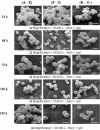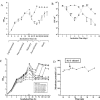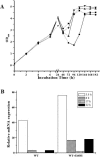Very low ethanol concentrations affect the viability and growth recovery in post-stationary-phase Staphylococcus aureus populations
- PMID: 16597967
- PMCID: PMC1449072
- DOI: 10.1128/AEM.72.4.2627-2636.2006
Very low ethanol concentrations affect the viability and growth recovery in post-stationary-phase Staphylococcus aureus populations
Abstract
Pharmaceuticals, culture media used for in vitro diagnostics and research, human body fluids, and environments can retain very low ethanol concentrations (VLEC) (< or =0.1%, vol/vol). In contrast to the well-established effects of elevated ethanol concentrations on bacteria, little is known about the consequences of exposure to VLEC. We supplemented growth media for Staphylococcus aureus strain DSM20231 with VLEC (VLEC(+) conditions) and determined ultramorphology, growth, and viability compared to those with unsupplemented media (VLEC(-) conditions) for prolonged culture times (up to 8 days). VLEC(+)-grown late-stationary-phase S. aureus displayed extensive alterations of cell integrity as shown by scanning electron microscopy. Surprisingly, while ethanol in the medium was completely metabolized during exponential phase, a profound delay of S. aureus post-stationary-phase recovery (>48 h) was observed. Concomitantly, under VLEC(+) conditions, the concentration of acetate in the culture medium remained elevated while that of ammonia was reduced, contributing to an acidic culture medium and suggesting decreased amino acid catabolism. Interestingly, amino acid depletion was not uniformly affected: under VLEC(+) conditions, glutamic acid, ornithine, and proline remained in the culture medium while the uptake of other amino acids was not affected. Supplementation with arginine, but not with other amino acids, was able to restore post-stationary-phase growth and viability. Taken together, these data demonstrate that VLEC have profound effects on the recovery of S. aureus even after ethanol depletion and delay the transition from primary to secondary metabolite catabolism. These data also suggest that the concentration of ethanol needed for bacteriostatic control of S. aureus is lower than that previously reported.
Figures






Similar articles
-
Staphylococcus aureus ClpC is required for stress resistance, aconitase activity, growth recovery, and death.J Bacteriol. 2005 Jul;187(13):4488-96. doi: 10.1128/JB.187.13.4488-4496.2005. J Bacteriol. 2005. PMID: 15968059 Free PMC article.
-
Identity of V factor in culture medium used for prior growth of two strains of Staphylococcus aureus.Int J Syst Bacteriol. 1992 Oct;42(4):642-4. doi: 10.1099/00207713-42-4-642. Int J Syst Bacteriol. 1992. PMID: 1390114
-
Alterations in the composition and bacteriophage-binding properties of walls of Staphylococcus aureus H grown in continuous culture in simplified defined media.Biochim Biophys Acta. 1975 Sep 16;406(1):60-7. doi: 10.1016/0005-2736(75)90042-5. Biochim Biophys Acta. 1975. PMID: 126088
-
Significant Changes in Cytoplasmic Amino Acid Composition Occur in the Transition between Mid-Exponential and Stationary Phases of Growth of Staphylococcus aureus: An Example of Adaptive Homeostasis in Response to Nutrient Limitations.Microorganisms. 2023 Jan 6;11(1):147. doi: 10.3390/microorganisms11010147. Microorganisms. 2023. PMID: 36677439 Free PMC article.
-
The Uptake and Release of Amino Acids by Staphylococcus aureus at Mid-Exponential and Stationary Phases and Their Corresponding Responses to Changes in Temperature, pH and Osmolality.Front Microbiol. 2020 Jan 23;10:3059. doi: 10.3389/fmicb.2019.03059. eCollection 2019. Front Microbiol. 2020. PMID: 32038532 Free PMC article.
Cited by
-
Genetic changes that correlate with the pine-oil disinfectant-reduced susceptibility mechanism of Staphylococcus aureus.J Appl Microbiol. 2008 Dec;105(6):1973-81. doi: 10.1111/j.1365-2672.2008.03956.x. J Appl Microbiol. 2008. PMID: 19120644 Free PMC article.
-
Mycofactocin Is Associated with Ethanol Metabolism in Mycobacteria.mBio. 2019 May 21;10(3):e00190-19. doi: 10.1128/mBio.00190-19. mBio. 2019. PMID: 31113891 Free PMC article.
-
Exploring amino acid and peptide transporters as therapeutic targets to attenuate virulence and antibiotic resistance in Staphylococcus aureus.PLoS Pathog. 2021 Jan 14;17(1):e1009093. doi: 10.1371/journal.ppat.1009093. eCollection 2021 Jan. PLoS Pathog. 2021. PMID: 33444418 Free PMC article. No abstract available.
-
Transcriptomic and metabolic responses of Staphylococcus aureus exposed to supra-physiological temperatures.BMC Microbiol. 2009 Apr 22;9:76. doi: 10.1186/1471-2180-9-76. BMC Microbiol. 2009. PMID: 19386094 Free PMC article.
-
A systems approach using OSMAC, Log P and NMR fingerprinting: An approach to novelty.Synth Syst Biotechnol. 2017 Oct 21;2(4):276-286. doi: 10.1016/j.synbio.2017.10.001. eCollection 2017 Dec. Synth Syst Biotechnol. 2017. PMID: 29552652 Free PMC article.
References
-
- Basu, T., and R. K. Poddar. 1994. Effect of ethanol on Escherichia coli cells. Enhancement of DNA synthesis due to ethanol treatment. Fol. Microbiol. (Praha) 39:3-6. - PubMed
Publication types
MeSH terms
Substances
LinkOut - more resources
Full Text Sources
Other Literature Sources
Molecular Biology Databases

